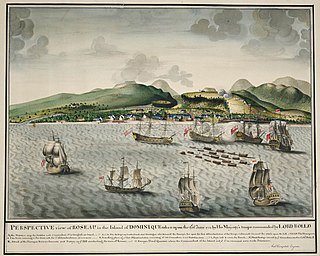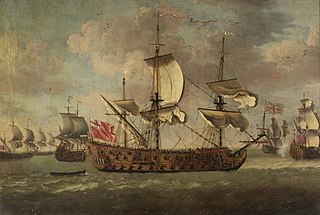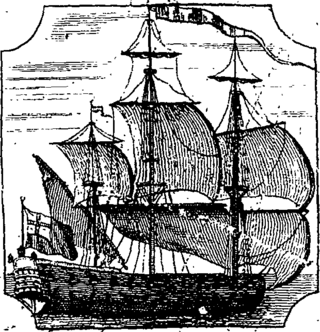
HMS Royal Oak was a 74-gun third-rate ship of the line of the Royal Navy, built by Jonas Shish at Deptford and launched in 1674. She was one of only three Royal Navy ships to be equipped with the Rupertinoe naval gun. Life aboard her when cruising in the Mediterranean Sea in 1679 is described in the diary of Henry Teonge.

HMS Dublin was a 74-gun third rate ship of the line of the Royal Navy, built by Adam Hayes at Deptford Dockyard and launched on 6 May 1757.

HMS Panther was a 60-gun fourth-rate ship of the line of the Royal Navy, launched on 22 June 1758 at Chatham Dockyard.
HMS Rupert was a 64-gun third rate ship of the line of the Royal Navy, launched at Harwich Dockyard on 26 January 1666 and broken up in 1769.

HMS Swiftsure was a 70-gun third-rate ship of the line of the Royal Navy, built by Sir Anthony Deane at Harwich, and launched in 1673. By 1685 she had been reduced to a 66-gun ship.
The English ship Speaker was a 50-gun third-rate. Speaker was built for the navy of the Commonwealth of England by Christopher Pett at Woolwich Dockyard and launched in 1650. At the Restoration she was renamed HMS Mary. She was the prototype of the Speaker-class.
Essex was a 48-gun third rate frigate built for the navy of the Commonwealth of England by Phineas Pett II at Deptford, and launched in 1653. Following the restoration of the English monarchy in 1660, she was commissioned into the Royal Navy as HMS Essex.
Lyme was a 52-gun third rate Speaker-class frigate built for the navy of the Commonwealth of England at Portsmouth, and launched in 1654.

President was a 38-gun fourth rate frigate of the Royal Navy, originally built for the navy of the Commonwealth of England by Peter Pett I at Deptford Dockyard, and launched in 1650.
HMS Assistance was one of six 40-gun fourth-rate frigates, built for the Commonwealth of England under the 1650 Programme, after the Restoration of the monarchy in 1660 she was incorporated into the navy of the Kingdom of England. During her time in the Commonwealth Navy she partook in the First Anglo-Dutch War being present in the battles of Kentish Knock, Portland and The Gabbard. In the Mediterranean she was present at the Battle of Santa Cruz and the bombardment of Porto Farina, In the Second Anglo-Dutch War she was involved in the Battle of Lowestoft, Battle of Vagen and the St James Day Fight. She did not participate in fleet actions after this. She spent the rest of her service life undergoing several rebuilds and plying the waters as a cruiser protecting British trade and projecting British sovereignty. After nearly 95 years of Service she was sunk as a break water at Sheerness at the end of 1745.
HMS Deptford was a 50-gun fourth-rate ship of the line of the Royal Navy, launched at Woolwich Dockyard in 1687. This was the second of three 50-gun ships ordered in 1682/3.

HMS Canterbury was a 60-gun fourth-rate ship of the line of the Royal Navy, launched at Deptford on 18 December 1693.

HMS Exeter was a 60-gun fourth-rate ship of the line of the Royal Navy, launched at Portsmouth Dockyard on 26 May 1697.

HMS Weymouth was a 50-gun fourth rate ship of the line of the Royal Navy, launched at Portsmouth Dockyard on 8 August 1693. She was one of two 50-gun ships ordered on 15 August 1690 to be built by Master Shipwright William Stigant at Portsmouth Dockyard. However, unlike the Norwich, the Weymouth was delayed until 1693 and - instead of the 123 ft length originally specified - was lengthened to 132 ft 4 in, thus becoming the prototype for the 1693 batch ordered with a design extended to some 130 ft.
HMS York was a 60-gun fourth rate ship of the line of the Royal Navy, built at Plymouth Dockyard and launched on 18 April 1706.

HMS St Albans was a 50-gun fourth rate ship of the line of the Royal Navy, built at Rotherhithe and launched on 10 December 1706.

HMS Hampton Court was a 70-gun third-rate ship of the line of the Royal Navy, built at Rotherhithe according to the 1706 Establishment and launched on 19 August 1709.

HMS Plymouth was a 60-gun fourth rate ship of the line of the Royal Navy, built at Devonport Dockyard to the 1706 Establishment of dimensions, and launched on 25 May 1708.
HMS Swallow was a 60-gun fourth rate ship of the line of the Royal Navy, built by Peirson Lock to the dimensions of the 1719 Establishment at the Yard at Plymouth Dock, and launched on 6 October 1732. She was renamed HMS Princess Louisa in 1737.

HMS Weymouth was a 60-gun fourth rate ship of the line of the Royal Navy, built at Plymouth Dockyard to the draught specified by the 1745 Establishment, and launched on 18 February 1752.












